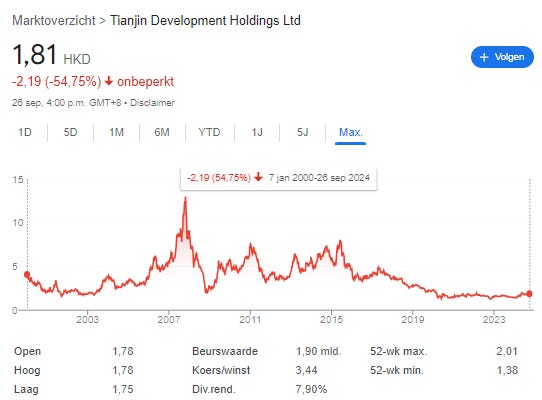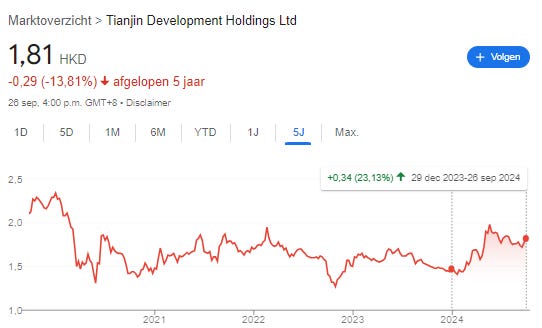Tianjin Development: Extreme discount is attractive
Holdings with a discount are common. The discount that Tianjin Development is trading at is quite absurd though. Below half of net cash & good quality assets make it interesting.
Tianjin Development Corp is a Chinese state-controlled holding company with a market cap of 1.9B. This does not sound very attractive, but the company has been making the right decisions, holds quality assets & 5.2B in net cash.
In this article I will make the case for Tianjin Development Corp.
Tianjin Development Corp has a diverse set of activities. I will first cover the strategic investments than their operating businesses and pharmaceutical investments.
Then I will cover the historic business and share price performance.
Lastly, I will discuss state owned enterprises & how I think of the getting returns going forward.
The first thing I want to get out of the way is that Tianjin Development Corp has no material direct real estate exposure. You might think that Tianjin Development Corp is a real estate developer given the name. This is not the case.
The only exposure to real estate development is indirect through its 16.55% stake in Otis elevator China.
Otis Elevator China
Otis Elevator China is the most valuable asset within Tianjin Development Corp. Otis makes money by keeping elevators running. Less growth is not good but does not kill the business. Installed elevators still need servicing and this is the most profitable part of the business. Results for Otis Elevator China decreased in H1 2024 by 23% but still netted Tianjin Development Corp 155M in profit.
I would value the stake in Otis Elevator China at 3.1B HKD (10 times earnings) more than total market cap of 1.9B. Also significantly more than the book value of this investment of HK$1.2B. This is still cheap given the inherent high business qualities of being a leading elevator company (Otis worldwide is trading at 26 times earnings). This asset alone makes Tianjin Development Corp a potentially interesting investment.
Tianjin Port
The other strategic investment is the 21% stake in Tianjin Port. The largest port in Northern China and the main maritime gateway to Beijing.
Tianjin Port is listed on the Chinese stock market with a total market cap 12.13B CNY. The valuation seems reasonable at 12.3 times earnings and a 2.4% dividend yield.
Tianjin Port Development is listed in Hongkong and is worth 3.6B HKD. The valuation looks very attractive at 5.4 times earnings, no net debt and an 8.0% dividend yield.
The 21% share by Tianjin Development is worth 0.76B HKD. Using the Hongkong shares. Using The Public A share valuation the stake is worth 1.60B HKD.
Other investments
Which are a bit more hidden in the reports are:
A 4.07% in the listed Binhai Investment Group. Binhai is active in the construction and operation of gas networks. Current market value is HK$1.4B. Stake of Tianjin is worth HK$57M.
A 12.15% in Tasly. A Chinese conglomerate mostly active in pharma but also in alcohol and the mineral water business. Tianjin Development values this at HK$1.15B. For me it is hard to value this company given the limited information available. A nice bonus asset I guess
Total value of Strategic and other investments is HK$3.9B
Operating businesses
Utilities
The bad thing about utilities is that returns on them are regulated and limited. The good thing is that the returns are quite predictable and fit relatively well with a state-owned enterprise.
This segment derives revenue from distribution of water (revenue 142M HKD in H1 ‘24 & 18M profit), heat and thermal power (revenue 626M HKD in H1 ‘24 & 40M profit). This is delivered to industrial, commercial and residential customers in the Tianjin Economic and Technological Development Area.
The result of electricity business of this segment is contributed by Tianjin TEDA Electric Power Co., Ltd. (revenue 1,144M HKD in H1 ‘24 & 28M profit). An investment accounted for using the equity method of the Group with a book value of HK$1.4B. This is too much given the low current profitability.
The profit together for the water, heat, thermal power and electricity segments in H1 2024 increased from 61M HKD to 82M HKD. Full year 2023 numbers are 1,600M revenue and 110M HKD profit. Using the lower 2023 numbers and a multiple of 10 leads me to a valuation of 1.1B HKD for the utility segment.
Hotel
Courtyard by Marriott Hong Kong, situated in a prime location on the Hong Kong Island, is a 4-star hotel with 245 guest rooms. It is positioned as an ideal lodge for business and leisure travelers.
For the six months ended 30 June 2024, revenue from Courtyard Hotel grew by 10.3% to approximately HK$66.6 million from HK$60.4 million in the corresponding period last year. Profit from Courtyard Hotel was approximately HK$15.2 million compared to HK$12.2 million in the same period last year. The average occupancy rate was 87.5% compared with 80.8% for the same period last year, and the average room rate remained stable.
Full year 2023 profit was HK$18M. Using 10 times the lower 2023 profits results in a valuation of HK$180M for the hotel. This is a heavy undervaluation of the property value even in the current downturn in China/Hong Kong real estate. The building was built in 2008 has 25 floors and 245 rooms in a central location in Hong Kong.
Electrical & mechanical
This segment has historically caused significant losses at Tianjin Development Corp. This makes sense given that this segment is a lot more competitive, and a slow-moving state-owned enterprise is likely to lose from more nimble competitors. Clearly a segment the conglomerate has no business being in.
The company has been divesting parts of this segment but in H1 2024 the losses again increased significantly. Increasing from HK$21M to HK$48M. In 2023 the loss was HK$23M on HK$167M of revenue.
The company states the following in its H1 2024 interim report:
The Group will continue to take cautious view with the operating performance of hydroelectric equipment business and may consider critically the advantages in its restructuring.
This is somewhat hopeful.
Closing down would clearly be beneficial. Not getting my hopes up and multiply the H1 2024 loss by 20 to reach a negative value of HK$960M. This might be too negative but also gives some room for poor future management decisions.
Pharmaceutical companies
Many investors with a value bend tend to stay away from pharmaceutical companies. Personally, I don’t think you need deep pharmaceutical knowledge to understand some pharma companies.
Tianjin Development has 3 minority investments in the pharma space. This is a competitive field but has not produced the same disastrous results as the electrical & mechanical segment.
These investments are classified as operational which is not the case with Tasly. The reason is that the company has some form of control.
Tianjin Lisheng Pharmaceutical is listed in China with a market cap of 3.9B CNY and trades at a reasonable 10.8 times earnings and has a 2.73% dividend yield. The 34% stake of Tianjin Development is worth HK$1.48B.
Tianjin Yiyao Printing is focuses on design, manufacture and printing for pharmaceutical packaging. Revenue was HK$84M in H1 2024. The value of this 44.55% stake is negligible.
The Tianjin Institute of Pharmaceutical research had a loss of HK$50.9M in H1 2024. Given the research focus this loss is not surprising to me. Book value is HK$587M. While I think that this institute might deliver some future benefits to Tianjin Development, I think a conservative valuation is HK$0.
Total value of operating businesses is 1.8B
Cash
Tianjin Development Corp not only has valuable operating assets but also a significant cash hoard. Including:
HK$3.8B in cash and cash equivalents
HK$1.9B in time deposits with a duration over 3 months
HK$1.1B in entrusted deposits
HK$0.4B in structured deposits
Total debt is HK$2.0B.
For a total net value of HK$5.2B on a HK$1.9B market cap.
Do not expect the company to pay this out as a special dividend. A better use case than cash or just higher interest rates might help earnings. Given the large cash balance further dividend increases are also likely in my opinion.
Total combined value of investments (HK$3.9B), operating businesses (HK$1.8B) and cash (HK$5.2B) is HK$10.9B.
This is still significantly below the stated book value of 12.5B but 5.7 times the value of the current market capitalization.
Historic share price performance
The long-term share price performance looks horrible. Kind of has to be to get to such a low valuation.
Looks lost and forgotten by the market. Company has been increasing its dividend. With a 37% increase in 2023 to 12.25 cents and more recently the interim dividend increased from 3.45 cents to 5.18 cents. The current yield is thus 7.7%%. This means investors are now getting paid to wait. In addition, it divested Tianjin Tianduan Press Co in 2021 for 510M CNY and a 12.7M CNY disposal gain. A great deal for a loss-making business. This solved a significant part of its long-suffering manufacturing assets. Now the remaining manufacturing assets perform bad as well. Not unrealistic that Tianjin Development will divest those assets as well.
YTD the performance of the shares has been pretty good. This might be surprising given the state of the Chinese (real estate) market. Might investors finally be willing to invest in this state-controlled company?
Government
Tianjin Development is a state-owned company controlled by the Tianjin Commission of Commerce. The Tianjin Commission of Commerce is an integral part of Tianjin Municipal Government which is in charge of internal & external trade and external economic cooperation in Tianjin.
Shareholder value maximization is not one of the goals for the Tianjin Commission of Commerce.
That being said the Tianjin Municipal Government can probably use some extra cash.
With real estate starts & sales in a tailspin, local governments have to look elsewhere for revenues.
What is easier than push an overcapitalized holding to pay out more of its earnings in dividends? Looking through this lens even a special dividend to cover a one-off cost might not seem too farfetched.
The risk is that Tianjin Development will waste capital for non-economic reasons. Looking back this has not happened it the company’s recent history.
SOE do play an important role in the Chinese economy. In general SOE tend to be more bureaucratic and less nimble than private companies. In certain areas like industry and service this is a clear problem.
Ownership of utilities, a port or a minority share in a well-run business are not harmed that much by a less nimble owner.
Multiple ways to win
Given the incredibly low valuation there are multiple ways to win
Investors can win simply by getting increasing dividends on an already high yield.
Investors can win by receiving a meaningful special dividend
Good use of a significant portion of the cash reserve
Divestment of non-core assets for Tianjin Development like Otis Elevator China & the Courtyard Hotel in Hong Kong.
Splitting the company in more focused business units. For example:
strategic investments & hotel
utilities
pharma
Electrical & Mechanical
Revaluation of the company
Conclusion
Tianjin Development Corp is trading at a huge discount to what I would consider fair value. The question is if you as an investor are going to get this value. The answer is not all. Given that it is a state-owned enterprise decisions will be made on other criteria than shareholder value maximization.
Investors do get a 7.9% dividend which is increasing at a decent rate. This gives investors a return while they wait.
There are multiple ways to win in this case. Even after doubling the shares look still incredibly cheap. My rough estimation of fair value was 5.7 times higher than the market price. This is the biggest differential I know of currently in the market.
I do not expect management to create value, but the stock can easily triple in value and still feel cheap. Contemplating a starter position.
Disclaimer: These are my ideas and not personal investment advice. I might own shares discussed and can sell those shares at all times. I don’t know your financial situation. Do your due diligence and do not blindly follow an article on the internet.











Otis China, Tianjin Port and the utilities business have moat and are probably worth at least HKD6 per share. Re the surplus cash balance, do you have a rough idea how much is actually owned by the company (vs the non-controlling interest)?